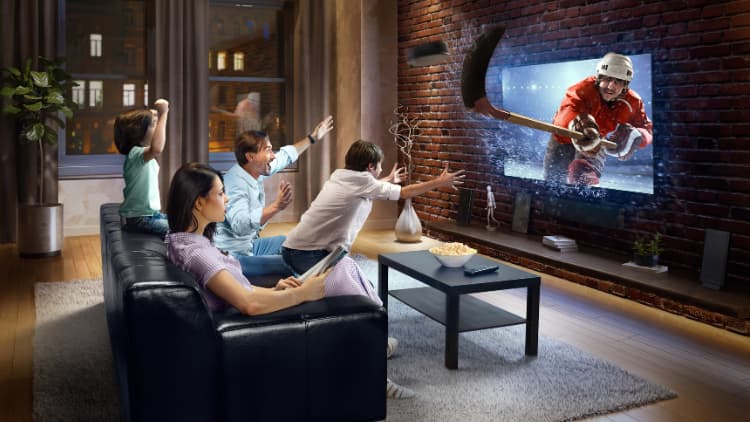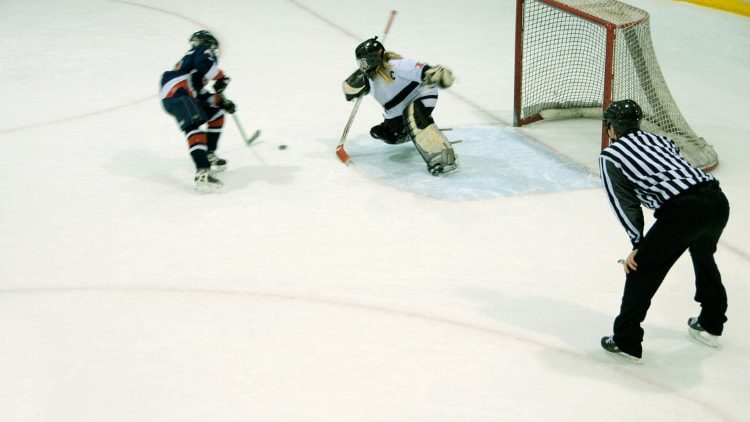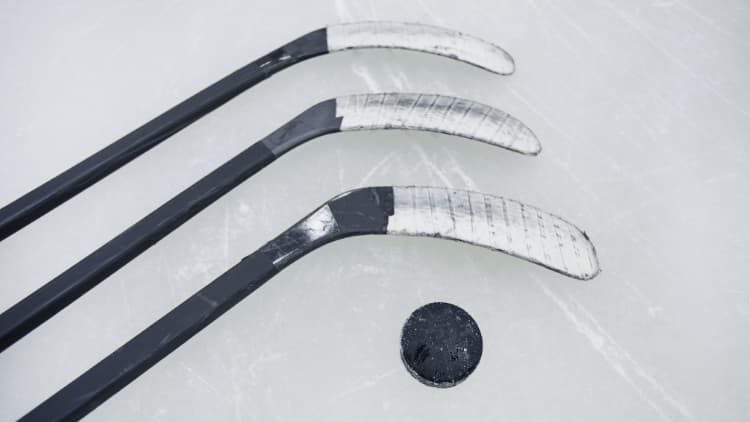How Long Are Hockey Games: Youth, High School, Professional
Wondering how long are hockey games or how many periods are in a game? Navigating the world of ice hockey, from youth games to the high-flying action of professional NHL, can be a whirlwind. But fear not, fellow hockey parents and enthusiasts! While NHL games run three (3) 20-minute periods each, there are intermissions, play stoppage, and other intricacies of game duration. In this article, I’ll simplify and break down not just the NHL duration and rules, but the time and periods across different levels – be it youth, high school, or the grand stage of professional hockey. Let’s dive into how long those games really are!
It aids in effective planning, ensuring you’re adequately prepared for the game’s ebbs and flows, from start to finish, and what to expect.
Understanding the Fundamentals: How Long are Hockey Games:
Structure of Ice Hockey Games – Periods, Intermissions, and Overtime.
Table of Contents
Periods in Ice hockey games are traditionally divided into three (3) periods, separated by two intermissions. Each period lasts a specific amount of time depending on the level (age and skill level) of play. If the score is tied at the end of regulation, an overtime period is added to determine a winner.
At the professional level, there are 3 periods of play that consist of 20 minutes each period. But you must allow time for stoppage of play for penalties, video analysis at the professional level, intermissions (Zamboni ice cutting between periods), and occasionally overtime (5-minute periods ).
Youth Hockey Levels and Game Durations
Mites (8U) through PeeWee (12 U)

- Game duration specifics – Atoms (6 and Under), Mites (8 and Under), Squirt (10 U) and Pee Wee (12 U) will most likely run about 12-minute periods. 3 Periods per Game.
- Common reasons for a stoppage in Youth hockey 6U through 12 U could be attributed to penalties (very few if any 6U and 8U. Intermissions allow for the coaches to direct the team in strategy and teaching. There is no ice cutting at intermissions. Other reasons for stoppage include officials needing to review play and time-outs.
- Squirt and Pee-Wees begin with off-sides and icing calls that will require some stoppage of the game to reset the game.
- The shortest running time would be 36 minutes to usually 60 minutes.
Bantam (14U):
- Game duration specifics – 15-minute periods. 3 Periods per Game. Intermissions (no ice cutting between periods)
- Distinguishing Bantam level stoppages in Bantam include penalties, officials needing to review play and time-outs, offside plays or icing are more frequent as teams attempt more structured breakouts and zone entries.
- Typical running time in total can run from 45 minutes to 90 minutes
Midget (16U/18U):
- Game duration specifics – 16-17 minute periods. 3 Periods per Game. (Some leagues run 25-minute periods, 2 Periods per game with ice cutting in between)
- Typical running time 60-90 minutes
- Midget-level game complexities and related stoppages can include the below as the players mature and develop physically:
- Advanced Tactics: At the Midget level, players and coaches start to employ more nuanced and intricate strategies. This leads to more frequent stoppages for reasons like offside plays or icing as teams attempt more structured breakouts and zone entries.
- Physicality: With some players nearly at their adult size and strength, the physical aspect of the game is intensified. This can result in more stoppages due to penalties, as body checks (usually at the Bantam Level) become more forceful, and the likelihood of minor infractions like hooking or tripping rises.
- Equipment Issues: Given the increased intensity, there’s a higher chance for equipment to become damaged or dislodged during play, leading to temporary stoppages. This includes incidents like broken sticks, goalie mask dislodgements, net displacements, or a player missing a mouthguard to the butt end of a stick. Whatever the official sees!
- Injuries: Unfortunately, with the elevated physicality and speed of the game, injuries become a more common sight. Whether it’s a hard hit or an awkward fall, play may be halted to ensure the safety and well-being of the player involved. Safety comes first.
- Time Management: As teams become more strategic, coaches may use their timeouts more wisely, often leading to stoppages in crucial moments of the game, especially in tight matchups.
- Face-offs: With a better understanding of the importance of puck possession, teams might deliberately cause stoppages to get a face-off in a desired zone, especially when the game is on the line.
- Understanding these complexities and related stoppages not only helps in appreciating the depth of the game at the Midget level but also prepares parents and spectators for the dynamic and unpredictable nature of these matches. It’s a thrilling preview of what’s to come as these young athletes transition to even higher levels of play.
High School Hockey Games:

- Most high school ice hockey games also feature 3 periods. Some regions or specific tournaments might have variations, but 15-18 minutes is the standard for many high school leagues.
- Stoppages time may be attributed to: Between each period, there’s usually a brief intermission when the ice is cut between the 2nd and 3rd period often lasting around 10-15 minutes. This time allows for the Zamboni to resurface the ice and for teams to strategize for the next period.
- Overtime: In the event of a tie at the end of the third period, some leagues or tournaments may have a 5-minute overtime period, to determine a winner. Yet, the specifics of overtime, whether extra OT periods, shootout, and sudden death rules can vary by the school league.
In total, if you consider the period durations and the intermissions, a standard high school ice hockey game can last anywhere from 1.5 to 2 hours.
It’s always a good idea to check with your local high school athletic association or the specific league’s rules to get the most accurate information on game durations in your region.
Professional NHL Hockey
The length of a hockey game in the NHL is typically longer than what you’d find at the youth or high school level.
Average NHL Game Duration
The average length of a game in the NHL is about 2.5 to 3 hours. While each of the three periods is 20 minutes long on the game clock, the actual game length extends due to stoppages for penalties, goals, puck out of play, and television timeouts. These frequent pauses, coupled with the 18-minute intermissions between periods, extend the viewing experience for fans, both in the arena and at home.
18-Minute Intermissions in Professional Leagues
Intermissions play a pivotal role in the flow and structure of professional hockey, especially in the NHL. These breaks, spanning 18 minutes, are strategically placed between periods, allowing teams to regroup, strategize, and rest. But the implications of these intermissions go beyond just a break for the players.
Between each of the periods, teams retreat to the locker room for intermissions, which provide pivotal breaks. The second period’s conclusion is especially known for a longer locker room interval, given the ‘long change’ where teams have a farther distance to their respective benches.

These breaks, essential for broadcasters to air commercial breaks, are seamlessly integrated into the game’s flow, ensuring viewers don’t miss any live-action. They add to the game’s length but are crucial for the commercial aspects of televised sports.
Overtime Rules during NHL Playoffs:
In playoff overtime, the rules are straightforward: the match continues until a team nets a goal.
After the regular playtime ends in a tie, both teams compete in a complete 20-minute overtime period. Contrasting the regular season’s 3 on 3 setups, playoff overtime sees teams playing 5-on-5.
The principle is sudden-death, meaning the game wraps up with the first goal scored. If the first overtime doesn’t produce a winner, the game extends to a second, third, or even more rounds until one team emerges victorious with a goal.
There are no shootouts in NHL playoffs.
Reasons for Stoppages in Hockey Games:
Even throughout every level of hockey, from grassroots to the National Hockey League, various factors can lead to a halt in-game time. Understanding these reasons for stoppage is vital for both players and spectators to anticipate and appreciate the dynamics of the sport.
Penalties: Infractions, from tripping to high-sticking, are part of the game’s fabric. These penalties, vital for maintaining the sport’s integrity and safety, can disrupt game flow, especially evident during playoff games where stakes are high, and emotions run rampant.

Equipment Malfunctions: Equipment issues can occur at any level. From a player’s broken stick to a net that’s dislodged during a goal attempt, these mishaps lead to brief pauses, ensuring everything is in order before play resumes.
Ice Maintenance: Especially crucial during second periods, the ice surface can get rough. A smooth rink is imperative, not just for the quality of play but for safety. Hence, during 15-minute intermissions, and sometimes spontaneously for quick fixes, the ice undergoes maintenance, which can add several minutes to the overall stoppage time.
Timeouts & Reviews: Coaches employ timeouts strategically, maybe to break an opponent’s momentum or discuss tactics, especially near the end of regulation time. In professional hockey games, especially in the National Hockey League, detailed video reviews are common to ensure the right calls are made, adding extra minutes to the game time.
Puck Out of Play: A frequent occurrence across all levels, when the puck sails over the glass or gets caught in the netting, the game halts momentarily. It’s a brief stoppage but one that can provide teams with a quick breather before diving back into the action.
By grasping these reasons for stoppages, fans and players alike can navigate the intricate ballet of hockey more adeptly, enriching their experience of this fast-paced sport.
Venturing into Overtime: The Longest NHL Game

Most NHL encounters wrap up within the standard three periods, maybe an OT period here and there.
However, when teams are locked in a tie, they plunge into extra sessions, adding more minutes to the game’s clock. Regular-season overtimes are designed for quick resolutions, but when it comes to playoff bouts, the match can stretch through numerous overtimes until a victor emerges.
Case in point: a monumental game in 1936 where the Detroit Red Wings clashed with the Montreal Maroons. This intense battle raged on for an astonishing six overtime periods, culminating when Mud Bruneteau of the Red Wings netted the decisive goal. Such drawn-out games, while rare and uncommon, underscore the game’s unpredictability and the stamina it demands from its players!
What’s the Sudden-Death System in Hockey? Understanding Sudden Death in Hockey:
During sudden-death overtime, teams compete with just three players each on the ice. The game concludes as soon as a team scores. If, after five minutes, neither team has scored, the match advances to a shootout (see below). ??
Shootouts in Hockey:
In a “Best Of” Shootout (e.g., best of 5, best of 7), the team that wins a Shootout (3 out of 5, or 4 out of 7) wins the game. When a game has already had an overtime period, a shootout becomes a sudden-death scenario: the first team to score wins the game.
Here’s a breakdown of how penalty shots come into play during these overtime games:
Execution of the Shot:

The chosen player starts from center ice and attempts to score on the goaltender with a single shot.
- The goalie must remain in their crease until the player touches the puck.
- Once the player starts their shot, they must maintain forward motion towards the goal. The play is considered over if the puck goes backward, the player stops, or the goalie makes the save.
Impact on the Series:
Given that overtime in playoffs is sudden death, a shootout shot becomes even more significant. If successful, not only does the game end, but it also brings the scoring team one step closer to winning the series. Conversely, if the shot is saved, the game continues, providing the other team with an opportunity to rally and possibly win. If it is the best of 5 or 7, the team that wins a Shootout (3 out of 5, or 4 out of 7) wins the game
Significance in Overtime:
If the overtime period is a sudden death (meaning the first team to score wins), a shootout shot becomes an incredibly intense and high-stakes moment. A successful shot will end the game, while a save can extend it.
In summary, in a “best of” playoff penalty shots during overtime can be crucial. They have the potential to shift the momentum of the game, and series and play a significant role in determining which team advances through the season, to sometimes playoffs.
A Timeless Hockey Tale:
Ah, the innocent mind of a 6-year-old! There I was, bundled up in the bleachers, sipping my lukewarm coffee, watching my son’s initiation into the world of ice hockey. Albeit, mine as well! Halfway through the game, as the kids were chasing the puck, my kiddo decided it was the perfect time for a little break. He just casually sat down on the ice, cross-legged, as if it were a picnic blanket. Confused, I watched him ask the referee, “Is it snack time yet?” he asked earnestly. The ref chuckled and said, “Not yet, but soon buddy”.
The entire rink erupted in laughter. The game came to a delightful standstill and just like that, my 6-year-old provided a room full of adults a priceless reminder: in the grand game of life, sometimes, it’s just about waiting for snack time. To this day, whenever a game seems too tense or competitive, I chuckle, remembering the day time stood still for snacks.

Closing Thoughts:
Ice hockey’s magic lies in its spontaneous spirit, where each match offers a distinct narrative. From friendly matches in neighborhood ice rinks to the adrenaline-pumping regular season games of professional hockey leagues, the game’s legacy in NHL history stands testament to its special moments. As games play out in real-time, hockey players’ skills and strategies can push matches into extra time, offering spectators an intensified viewing experience that’s ever-changing and is sure to keep you on the edge of your seat.
For the resilient ice hockey parents, preparing for these unpredictable journeys is essential. Remembering to bring snacks ensures no hunger pangs during extended breaks or unexpected extra time. Keeping devices fully charged helps in immortalizing those unforgettable moments at the ice rink. And while the game is on, connecting with fellow parents can make stoppages feel shorter, weaving threads of community and camaraderie. In the vast universe of hockey, it’s the collective experiences and mutual encouragement among parents that create a warm, familial atmosphere.



